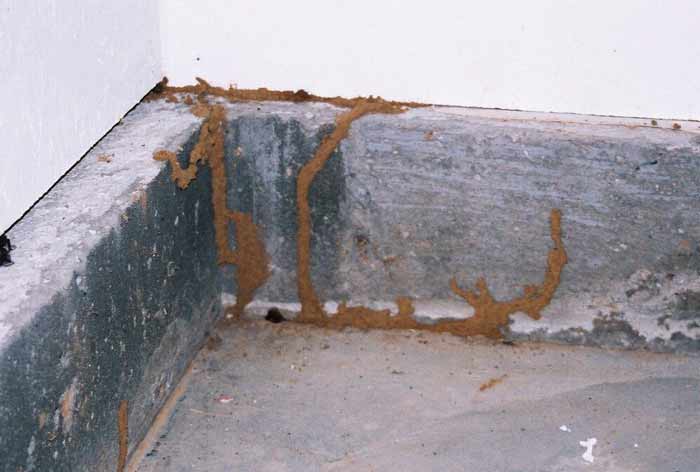It is important to know the early and late signs of termite infestation if you want the control measures to be more effective. The early signs are the very first indicators when an infestation is not very severe while the late signs are seen when the infestation becomes very serious. Read on to learn more.
Table of Contents
Early signs of termite infestation
Some of the first signs you will see when you have a termite infestation include the following;
Small pellets of wood
In the case of drywood termites, this is one of the evidence they leave behind. Usually, the termites themselves may not be seen since they spend most of the time hiding in your wood structures and causing damage.
When these termites burrow into the wooden structures, they leave small wooden pellets that are of the same size. As soon as you spot these pellets, look further for more signs of a termite infestation and most advisably, involve a professional for easier identification of such signs.
Swarms
Another sign that you have a termite infestation is the presence of termite swarms around your home or in your garden.
Swarms refer to young termites that have left their home colonies in order to start new families.
As soon as you spot these swarms around your home, you are advised to take action towards termite treatment since it is a sign the termite have already made a home in your home or they soon will.
It is not obvious that the home for the rest of the termites is around the place you see the swarm and you may need to search for some time before you can trace their origin.
A swarm simply indicates that more termites have been left behind.
Termite fecal matter
Also referred to as frass, termite feces which are often pushed out of the galleries are a sign of termite infestation.
If you notice some black marks which are very small and a powdery substance that is dark colored around your house, you should know that you are likely to have a termite infestation.
This is mostly observed in the case of drywood termites which do not use their fecal matter to construct their nests.
It is the drywood termites that like to keep their nests very tidy and they therefore push away any frass from their nest. Subterranean termites are different in that they use their frass to construct their tunnels.
You must clearly know how termite frass looks like. It is confused for sawdust since it looks exactly like it and you therefore must be careful when you come across it. When unsure of whether its frass or just saw dust, seek professional advice or look out for other characteristics of termite frass.
Tree nests
Although termite nests may be hard to find when they are constructed inside trees, they will often extend the outside when the number of termites has increased. You will see a chunk of mud from the outside of the tree.
You may see more than one nest on a particular tree since the millions of termites may need a bigger home for all of them to be well protected. Always do a thorough check up of your wooden structures as often as possible.
Cracks and fissures
When the termites have eaten into the wood for a very long time, you are likely to notice some cracks on the wooden structures. This sign goes hand in hand with the hollow sound.
Presence of holes
If you examine a wooden structure and notice severe holes drilled on it, you are likely to be having a termite infestation. These holes are used by the termites as an exit from their nest which is usually constructed inside the wood.
Nevertheless, it is difficult to find the holes since in most cases, the worker termites keep the holes closed. Termite droppings may be used to close the openings. The holes could also have been drilled by other insects so you need to always look out for more evidence before you can conclude that they are termite holes.
Mud tubes
Made out of soil, termite mud tubes are channels made of soil. These tunnels are usually very small and can sometimes be constructed using dirt which has accumulated around the wood.
The mud tubes can be found almost everywhere where there is termite food. It is this tunnels that connect the termite nest to the food source.
Subterranean tunnels
Unlike the drywood termites, the subterranean termites construct tunnels in place of tubes. You therefore can conclude that you have a termite infestation if you realize there are tunnels underground. Do not just search for termite signs on wooden structures alone, you must remember that subterranean termites live underground.
Earthen packing
A mud like earthen packing is produced when termites are working inside a piece of timber. This is usually seen on the joints and foundations of the walls.
Homeowners report that termites destroy the joints and foundations of walls. Even though it may not be very common, this is very crucial evidence that you have termites in your home and you ought to seek professional help.
Bubbling or uneven paint
There are two reasons the paint on your wall may start peeling off. One of them is the possibility of water having come into contact with the paint or if there is moisture produced by termites. Moisture build up by the termites causes the paint to become weak and it as a result falls off.
Live termites
Sometimes, seeing a live termite could be the best sign that your home is highly infested with termites. You must clearly know the difference between a termite and other similar insects such as ants. If you come across a live termite, you must ensure that it has pointed antennae and a thick waist.
Late Termite evidence and Activity
When the termites have lived in a particular place for a very long time, there are some signs that are considered late signs of a termite infestation. At such a ‘late’ point in time, the termite infestation is very severe. Below are some of the late signs that you have termites around your home;
Discarded wings
One of the most common sign of termite infestation is dead wings. The two most common instances when termites shed their wings is if they are dead or when the king and queen want to mate to start new colonies.
If you come across broken wings that are of the same size, it is a sign of danger and a confirmation that there are termites round your home.
You should not confuse the wings of an ant and that of a termite and that explains why you must keenly check the size of those wings.
Where the wings are not of the same size, you have other insects like ants in your home and not termites.
Hollow wood
When the drywood termites eat the timber making up the wooden structures, they do so from inside leaving a huge space. If you suspect a termite infestation, tap the structure to hear if a papery or hollow sound is produced.
It is the emptiness left on the wood that produces the hollow sound. By the time the hollow sound can be produced once the wood is tapped, the termites must have been on that particular wood for a very long time. Such sounds imply that the termites have chewed almost every timber that is inside the wooden structure in question.
Knocking and clicking noise
From time to time, you may hear some soft clicking sounds on tapping your wooden structures. The noise may also come from the walls of your house. The sounds are produced when the soldier termites bang their heads to alert the whole colony of possible danger.
The sound may also be produced when the termites shake their bodies. When you stand next to a wooden structure that is infested with worker termites, you will hear some noise since these termites are noisy eaters. Putting your ear next to the wood structure makes the noise clearer to you.
When you put loud music around areas infested with termites, you are likely to hear the noise even better since termites are known to respond to any form of vibrations by making random movements. Research points out that, the termites do not actually hear the music but the vibrations that come from such music.
Difficulty in opening windows and closing doors
If your door or window is made of wooden structures, they may at some point become stiff to close or open. There are many reasons that explain this occurrence but one of them, although rare, is often left out; the presence of termites.
When eating wood and tunneling through the frames of your doors and windows, the termites produce moisture which causes the doors and windows to become warped. You should not buy lubricants to correct the problem before you are confident there are no termites anywhere in your house.
Blistering or darkening of termite structures
When termites have stayed or been tunneling through your wooden structures for a very long time, you may realize that, due to moisture accumulation, some parts of your wooden structures darken. This kind of blistering makes the wooden structures less attractive.
Further Reading
- Subterranean Termites Swarmers Treatment Cost, Damages & Pictures
- Flying Termites with Wings (Swarmers) Pictures & How to get Rid
- Termite Droppings-Drywood, what they look like, Health Risks, Clean vs Sawdust
- Formosan Termites Pictures, Signs Treatment & Damage
- How to Get Rid, Kill Termites + Treatment Cost
- What Causes & Attracts Termites?
- Do Termites Bite Humans? Pictures & Remedies
- Flying Ants vs Termites-Differences & Similarities
- Termite Inspection Cost, Procedure, how long it takes & Training
- Termite Colony-Queen, Soldier, Worker & King
- Drywood Termites Treatment Cost, Get rid & Damage
- Termite Bond Cost, Benefits
- Termite Baits, Stations & DIY Traps
- Dampwood termites Pictures, Damage & Treatment
- Termite Tenting & Fumigation- Cost, Preparation, Safety & Cleaning After
- Termite Barriers (Shields): Types, Cost, how they Work & Products
- Termites Damage, Pictures, Repair Cost, Ceiling, Floors, Wood & Fix
- Best Termite Sprays-Orange Oil (DIY), Boric Acid & Spectracide Reviews
- Termites Life Cycle & Span-Eggs, Larvae, Baby & Adults
- How to Prevent Termites-Tips to Protect your Home
- Signs of Termites Infestation-How do you know if have you them?
- What do Termites look like? Pictures, Size, Color & Look-alikes
- Termites: Where From, Habitat, Eat, Noise, Types +more!



I like that you pointed out how the presence of termite swarms around your home or garden is a sign of termite infestation. I was tending to the plants in our garden yesterday and I noticed some bugs flying around, which seemed like termites. We can’t just leave these termites alone, so we should definitely call for termite services to take care of them.